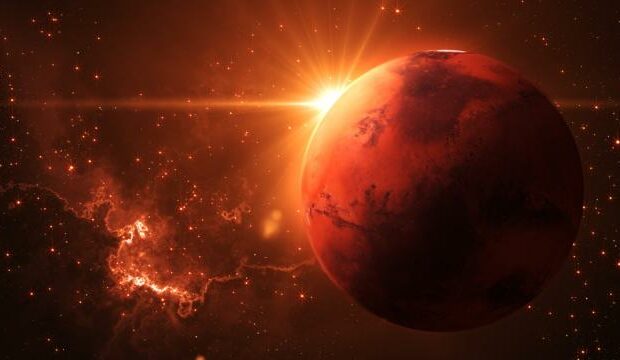As the solar maximum approaches this year, two NASA spacecraft will monitor the rising radiation levels that strike Mars closely in an effort to better prepare astronauts for trips to the Red Planet in the future.
Due to its powerful and ever-changing magnetic fields, the sun undergoes a solar maximum, or peak in activity, every 11 years or so. Powerful streams of solar radiation are sent into deep space by solar flares and coronal mass ejections, which are caused by an increase in sunspot frequency and intensity during this phase of the solar cycle.
While Mars is not protected from the effects of solar storms to the same extent that Earth is, this is because the Red Planet lost its worldwide magnetic field a long time ago. Mars is therefore more susceptible to strong solar activity than are any resident spacecraft or manned missions to the planet in the future.
According to a space agency release, this is the reason why NASA’s MAVEN (Mars Atmosphere and Volatile EvolutioN) orbiter and Curiosity rover will collaborate to study solar particles and radiation pouring toward Mars from both far above the planet and at its surface.
Shannon Curry, the MAVEN main investigator, stated in the statement that “we don’t have a solid handle on what the effect is from radiation during solar activity” for people and assets on the Martian surface. “I’d actually love to see the ‘big one’ at Mars this year — a large event that we can study to understand solar radiation better before astronauts go to Mars.”
When both spacecraft work together, they can examine the amount and energy of solar particles that make it to Mars. Researchers can determine how much protection astronauts exploring Mars may need by measuring how the planet’s thin atmosphere affects particle intensity that reaches the surface and how radiation breaks down carbon-based molecules on the surface using Curiosity’s Radiation Assessment Detector instrument, or RAD.
The comment from Don Hassler, the lead investigator of RAD, stated, “You can have a million particles with low energy or 10 particles with extremely high energy.” “While MAVEN’s instruments are more sensitive to lower-energy ones, RAD is the only instrument capable of seeing the high-energy ones that make it through the atmosphere to the surface, where astronauts would be.”
Together, MAVEN and Curiosity enable the rover crew to monitor changes in the RAD data when the orbiter detects a solar flare. As a result, when radiation levels are predicted to grow, the MAVEN mission also offers other Mars spacecraft teams an early warning system so they can disable sensitive instruments.
The beginning of Mars’ dustiest season, which is brought on by the planet’s heated atmosphere during perihelion, the point in its orbit when it is closest to the sun, coincides with this year’s solar maximum. According to the statement, if a worldwide dust storm coincided with a solar storm, it might provide light on how Mars turned into the icy desert it is today.
NASA officials stated in the statement that “While there’s little water left on Mars — mostly ice under the surface and at the poles — some still circulates as vapor in the atmosphere,”
“Scientists wonder whether global dust storms help to eject this water vapor, lofting it high above the planet, where the atmosphere gets stripped away during solar storms,” they stated. “One theory is that this process, repeated enough times over eons, might explain how Mars went from having lakes and rivers to virtually no water today.”








